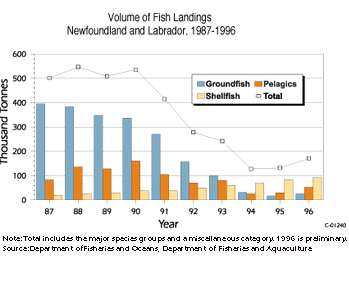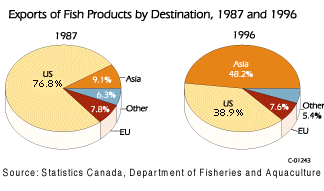5.0 The Fishing Industry from 1987-96
 |
 |
In 1996 the landed value of the fish harvest was $240 million and provided jobs for an estimated 13,000 harvesting workers and 10,000 fish processing workers. Many of these workers are also clients of the TAGS program. Without the groundfish component of the industry, however, fisheries employment remains well below historical levels. As a result, a considerable number of TAGS clients are unable to work in the industry and must rely upon TAGS to replace the income lost.
In 1992, low biomass levels resulted in the closure of commercial fishing for 2J3KL cod, and in 1993, the 3Ps and 4RS3Pn cod fisheries were closed. Since that time, other stocks such as redfish, American plaice, flounder and turbot were also placed under moratoria. The result of these closures has been the displacement of many workers from the fisheries. The NCARP and TAGS programs were designed to provide income support and adjustment measures for individuals most affected by the crisis.
These developments have caused groundfish landings to drop significantly over the past ten years. In 1987, 395,000 tonnes of groundfish were landed; however, by 1996 landings had declined to 25,000 tonnes, about six percent of the earlier landings level. This decline was directly attributable to the moratoria on cod and other stocks. (For a graphical overview of the landings of various species see Appendix 6.0).
Many reasons have been suggested to account for the decline in groundfish stocks. They include: deficiencies in fisheries science; foreign overfishing of straddling stocks; inadequate enforcement of both domestic and foreign fleet sectors; changes in environmental conditions/recruitment impacts; and growth of the seal population. Nonetheless, some stocks have shown signs of recovery and after about four years under moratoria, a limited commercial cod fishery was permitted in 4RS3Pn and 3Ps this year.
 The
collapse of major groundfish stocks and a decline in
traditional catches of capelin in conjunction with the
rise of the shellfish sector have impacted the industry
in other ways. For example, with the significant changes
in the composition of output in the fishing industry over
the past few years, markets have also shifted. In 1987,
about 77 percent of fish exports went to the United
States and about nine percent to Asian countries. Because
the United States was an important market for groundfish
products and Asian markets have a strong preference for
shellfish, in 1996 only 39 percent of fish exports went
to the US while 48 percent was exported to the far east,
Japan and China in particular.
The
collapse of major groundfish stocks and a decline in
traditional catches of capelin in conjunction with the
rise of the shellfish sector have impacted the industry
in other ways. For example, with the significant changes
in the composition of output in the fishing industry over
the past few years, markets have also shifted. In 1987,
about 77 percent of fish exports went to the United
States and about nine percent to Asian countries. Because
the United States was an important market for groundfish
products and Asian markets have a strong preference for
shellfish, in 1996 only 39 percent of fish exports went
to the US while 48 percent was exported to the far east,
Japan and China in particular.